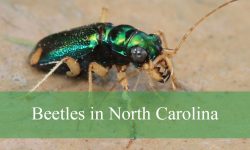If you love birdwatching, Tennessee is a wonderful place to see owls in their natural habitats. These mysterious birds of the night live in forests, farmlands, and even near quiet neighborhoods. Each species has its own charm—some are large and fierce like the Great Horned Owl, while others, such as the Eastern Screech-Owl, are small and full of character. Their calls fill the evening air with hoots, trills, and screeches that make every night feel alive.
For many bird lovers, hearing or spotting an owl is a magical experience. Their silent wings, glowing eyes, and calm presence create an unforgettable moment in the wild. In Tennessee, they can be found from the Appalachian foothills to the wide open farmlands of the west. Patience, a flashlight with a red filter, and a bit of luck are often all you need to find one resting in the trees or gliding across the moonlight.
This guide introduces ten species of owls found across Tennessee. It will help you recognize their calls, understand their habits, and discover the best places to observe them. Owls are more than just night hunters—they’re a symbol of the wild beauty that makes Tennessee such a special place for birdwatchers.
Types of Owls Found in Tennessee
Great Horned Owl (Bubo virginianus)
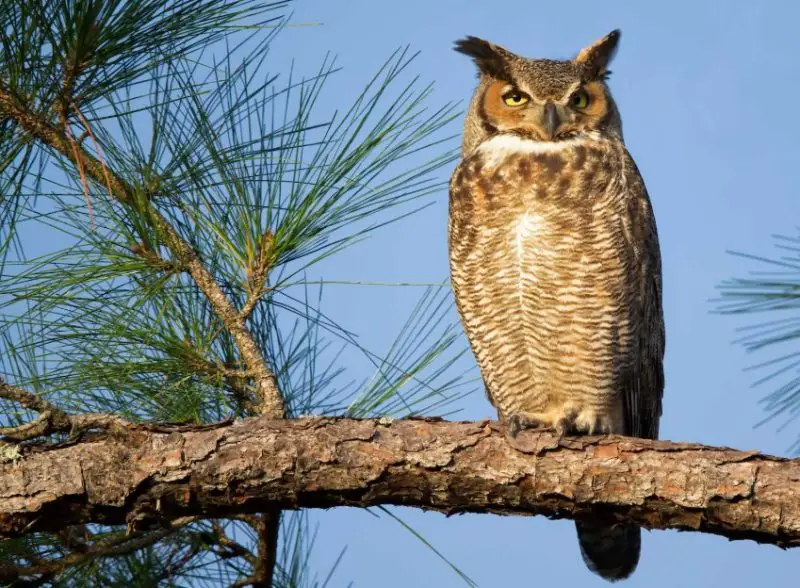
The Great Horned Owl is one of the most powerful and widespread owls in Tennessee. This large bird of prey stands between 18 to 25 inches tall, with a wingspan that can reach nearly 5 feet. Its prominent feather tufts, often mistaken for ears, give it a distinct and intimidating silhouette. The plumage is a mix of brown, gray, and white with dark barring, providing excellent camouflage against tree bark and forest backdrops.
This species is easily recognized by its deep, resonant hoots—typically delivered in a rhythmic series that carries far through Tennessee’s forests at night. It has striking yellow eyes and a strong, curved bill, features that complement its predatory lifestyle. Unlike many smaller owls, the Great Horned Owl exudes a commanding presence both visually and vocally.
Behaviorally, Great Horned Owls are highly territorial and often occupy the same nesting sites year after year. They hunt mostly at night, swooping silently to capture prey that includes rabbits, squirrels, skunks, and even other birds. Their feather structure allows for nearly soundless flight, making them one of nature’s most efficient nocturnal predators.
In Tennessee, they inhabit diverse environments—from dense woodlands to open farmlands and suburban parks. They are year-round residents throughout the state, thriving in both the Appalachian foothills and lowland regions. Their adaptability to human-altered landscapes makes them one of the most commonly observed owls in Tennessee.
Barred Owl (Strix varia)
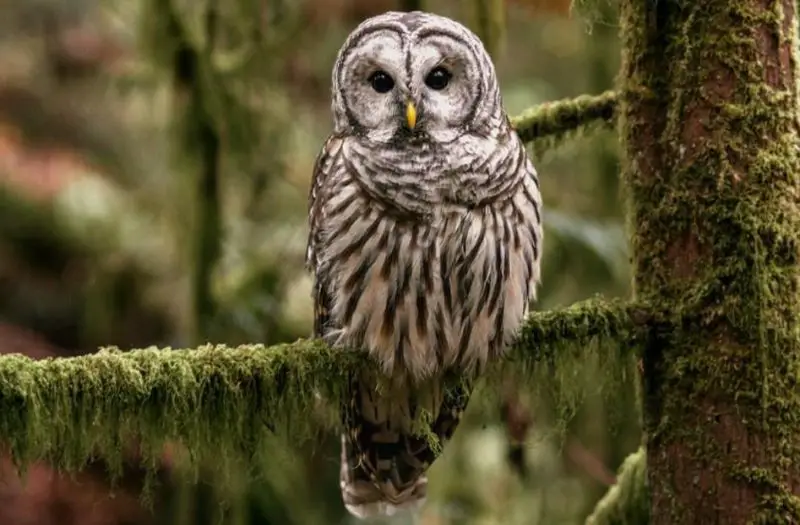
The Barred Owl is a large, round-headed species that’s easy to identify by its classic “Who cooks for you? Who cooks for you all?” call echoing through Tennessee’s forests. Adults measure around 17 to 20 inches in height with a wingspan between 39 and 44 inches. Their soft brown and white plumage is marked with horizontal barring on the chest and vertical streaks on the belly, giving them a distinctive striped appearance.
Unlike the Great Horned Owl, the Barred Owl lacks ear tufts and has large, dark brown eyes that lend it a soulful expression. These owls are known for their friendly curiosity and are often seen perched near wooded creeks or swamps. Their round facial disc helps funnel sound to their ears, providing exceptional hearing that aids in locating prey even under dense leaf litter.
Barred Owls primarily hunt small mammals, birds, amphibians, and even crayfish. They prefer still or slow-moving waters where prey is abundant. They are active mainly at night but sometimes call and move during the day, especially in overcast conditions. Their flight is slow and buoyant, with wings beating silently as they glide through the forest understory.
In Tennessee, Barred Owls are common year-round residents in mature forests, river valleys, and wooded wetlands. They are especially prevalent in the eastern and central parts of the state, where dense tree cover and water sources provide perfect nesting and hunting conditions. They often compete with Great Horned Owls for territory, though the Barred Owl tends to prefer wetter, more enclosed habitats.
Eastern Screech-Owl (Megascops asio)
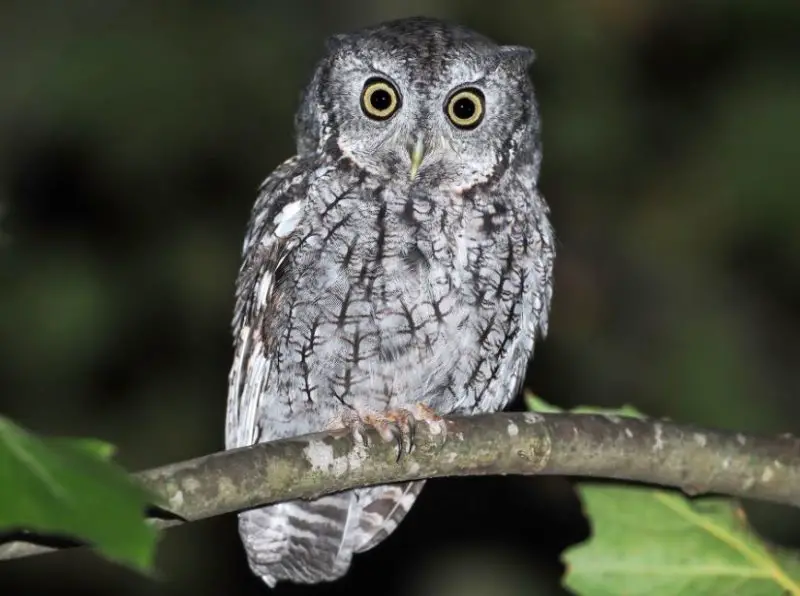
The Eastern Screech-Owl is one of the smallest and most adaptable owls found in Tennessee. Standing only about 6 to 10 inches tall with a wingspan of 18 to 24 inches, it’s a compact bird with a stocky build. Its plumage comes in two color morphs—gray and reddish-brown—both of which blend seamlessly with tree bark, making it nearly invisible when roosting. The facial disc is edged with fine feathering, and small ear tufts add to its charming yet fierce appearance.
Despite its name, this owl doesn’t actually “screech.” Its calls include a series of soft trills or a descending whinny-like sound, which can be heard at dusk or during the night. These vocalizations are often used to mark territory or communicate with mates. Their eyes are bright yellow, and their expression can appear almost mischievous when spotted in a tree cavity.
Eastern Screech-Owls are opportunistic hunters, feeding on insects, small mammals, birds, and even fish or frogs. They often hunt from a perch, swooping down to grab prey with precision. During winter, they may cache extra food in tree hollows to eat later. They nest in natural tree cavities or abandoned woodpecker holes, and they readily use nest boxes provided by humans.
In Tennessee, they inhabit a wide range of environments including woodlands, suburban neighborhoods, and orchards. They are found throughout the state year-round, thriving in both rural and urban settings. Their ability to adapt to human presence makes them one of Tennessee’s most familiar and endearing owl species.
Barn Owl (Tyto alba)
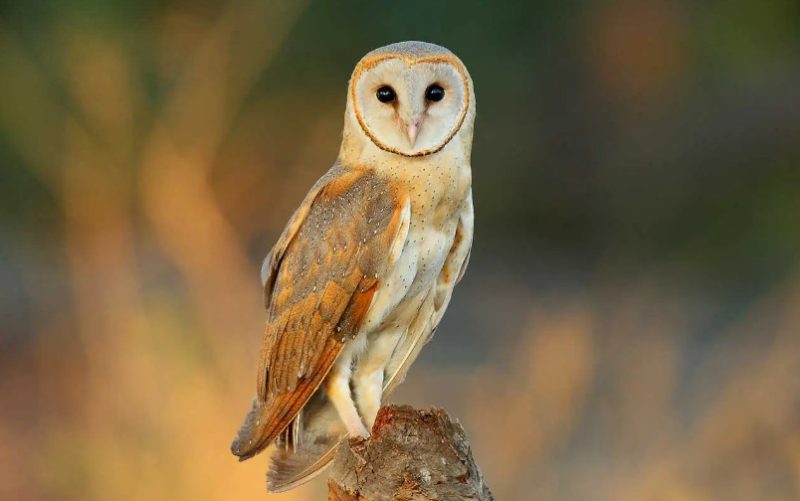
The Barn Owl is a distinctive species known for its ghostly pale appearance and heart-shaped facial disc. Measuring 12 to 16 inches tall with a wingspan of 39 to 49 inches, it’s a slender owl with long legs and a graceful flight. Its plumage is pale golden on the upper parts and white underneath, creating a striking contrast when seen under moonlight. Its dark eyes stand out against its white face, giving it a haunting yet elegant look.
This owl’s call is unlike any other—a long, harsh, rasping screech rather than a hoot. It often calls while flying over open fields at night, a sound that can startle those unfamiliar with it. The Barn Owl’s feathers are exceptionally soft, enabling completely silent flight, which helps it surprise its prey. Its keen sense of hearing allows it to detect small animals even in total darkness.
Barn Owls feed mainly on rodents such as mice, voles, and rats, making them invaluable allies to farmers. They hunt primarily in open habitats, gliding low over fields and meadows. They often nest in barns, silos, or hollow trees, using old buildings as convenient nesting shelters. Their diet and nesting preferences make them a familiar sight in rural Tennessee.
In Tennessee, Barn Owls are found throughout the state, particularly in agricultural areas and open countryside. They prefer lower elevations with access to farmland or grassland. While once more common, their populations have declined in some regions due to loss of nesting sites and agricultural changes. Conservationists encourage the installation of nest boxes to support their numbers.
Northern Saw-whet Owl (Aegolius acadicus)
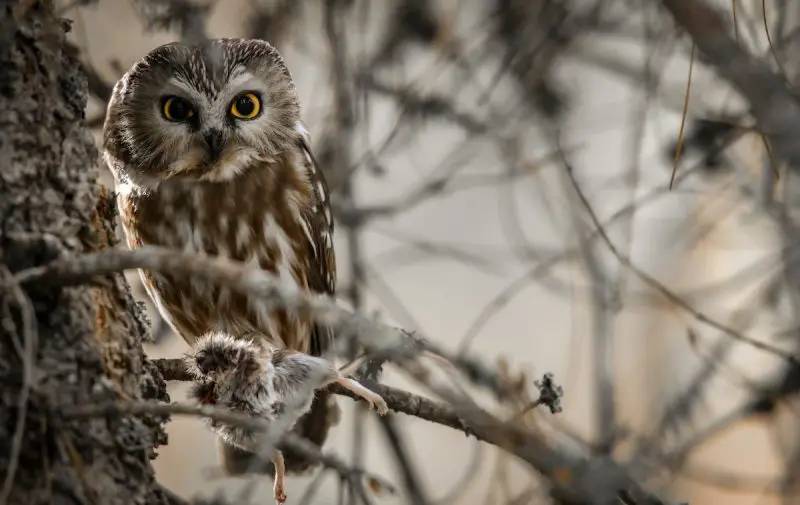
The Northern Saw-whet Owl is one of the smallest and most elusive owls in North America, and in Tennessee, it’s considered an uncommon winter visitor. Adults measure only about 7 to 8 inches tall with a wingspan around 17 inches. Their compact body, oversized head, and bright yellow eyes give them an endearing, doll-like appearance. The name “saw-whet” comes from its repetitive, high-pitched call that resembles the sound of a saw being sharpened.
This tiny owl has a brown back with white spotting and a streaked chest. It lacks ear tufts, giving its head a rounded look. When perched, it often remains motionless, relying on its coloration to stay hidden among dense branches. Because of its secretive nature and nocturnal habits, it’s rarely seen even by experienced birdwatchers.
Northern Saw-whet Owls primarily feed on small mammals, especially deer mice, but will occasionally take small birds and insects. They hunt at night from low perches, swooping down silently to seize their prey. They store extra food in cold weather, often hanging it in nearby branches or hiding it in cavities.
In Tennessee, sightings of the Northern Saw-whet Owl occur mostly in the Appalachian region and the northern parts of the state during winter. They prefer coniferous or mixed forests, often near mountains or wooded valleys. Their presence in Tennessee is seasonal, with individuals migrating further north once spring arrives.
Short-eared Owl (Asio flammeus)
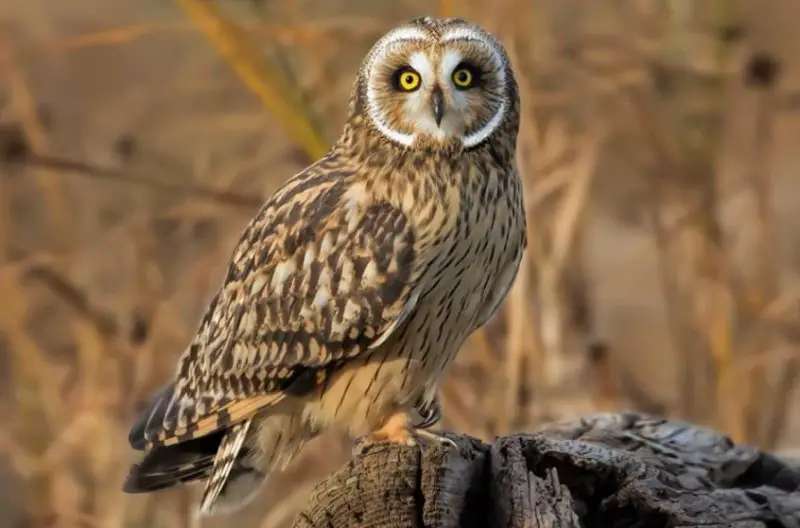
The Short-eared Owl is a medium-sized, migratory owl that visits Tennessee mainly during the winter months. Measuring about 13 to 17 inches in length with a wingspan of 33 to 43 inches, this owl has a slender body and rounded wings. Its plumage is buffy brown with dark streaks, helping it blend into grassy landscapes. Unlike many owls, its ear tufts are barely visible and usually only seen when the bird is alarmed. Its face is pale with yellow eyes surrounded by black patches, giving it a fierce expression.
This owl’s flight is buoyant and moth-like, often seen gliding low over open fields during dawn and dusk. Its call is a soft series of barks or hoots, but it’s generally a quiet species, relying more on stealth than vocalization. The Short-eared Owl is diurnal to crepuscular, meaning it hunts both during the day and twilight hours. It is one of the few owl species regularly seen flying in daylight, particularly in the open farmlands of western and middle Tennessee.
Short-eared Owls feed primarily on small mammals such as voles, mice, and shrews, though they also hunt small birds when rodent populations are low. They use their excellent hearing and silent flight to pinpoint prey movement beneath the grass. Unlike most owls that nest in trees, this species nests on the ground, lining its nest with grass and down feathers.
In Tennessee, Short-eared Owls are most often found in large open areas—prairies, hayfields, and marshlands. They are more commonly observed in the state’s western regions during winter migration. Because they depend on open grassland habitat, their numbers can fluctuate greatly from year to year, depending on rodent populations and habitat conditions.
Long-eared Owl (Asio otus)
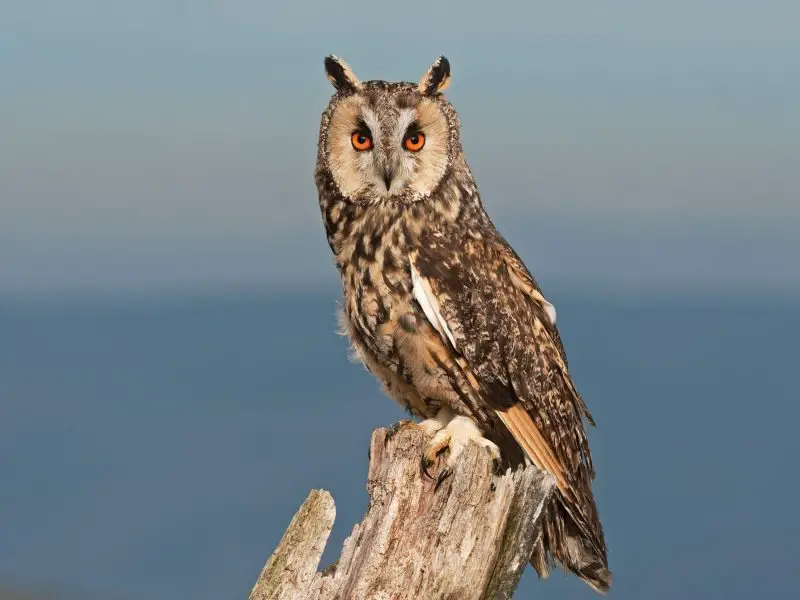
The Long-eared Owl is a secretive and slender species, known for its tall ear tufts that give it a striking silhouette. Adults measure about 13 to 16 inches long with a wingspan of around 35 to 40 inches. Its plumage is mottled brown and buff with fine streaks, blending perfectly with tree bark. The facial disc is orange-tan with striking yellow eyes and black outlines, making it one of the most beautifully marked owls in North America.
This owl is primarily nocturnal and extremely shy, often roosting quietly in dense pine or cedar trees during the day. It’s rarely seen unless accidentally flushed. When disturbed, it stretches its body vertically and raises its ear tufts to mimic the shape of surrounding branches, an impressive camouflage behavior. Its call is a series of deep, low “hoo” sounds that carry across the night air, though it remains mostly silent during migration.
Long-eared Owls hunt mainly small mammals such as mice, voles, and shrews, occasionally taking small birds. They typically hunt by quartering open areas at night, flying low and using their exceptional hearing to locate prey. They often use old stick nests built by crows or hawks instead of building their own.
In Tennessee, Long-eared Owls are uncommon winter visitors. They are most likely to be found in the northern and western parts of the state, where they roost in conifer stands near open hunting grounds. Because of their secretive nature and excellent camouflage, they are one of the most difficult owl species to spot in Tennessee.
Snowy Owl (Bubo scandiacus)
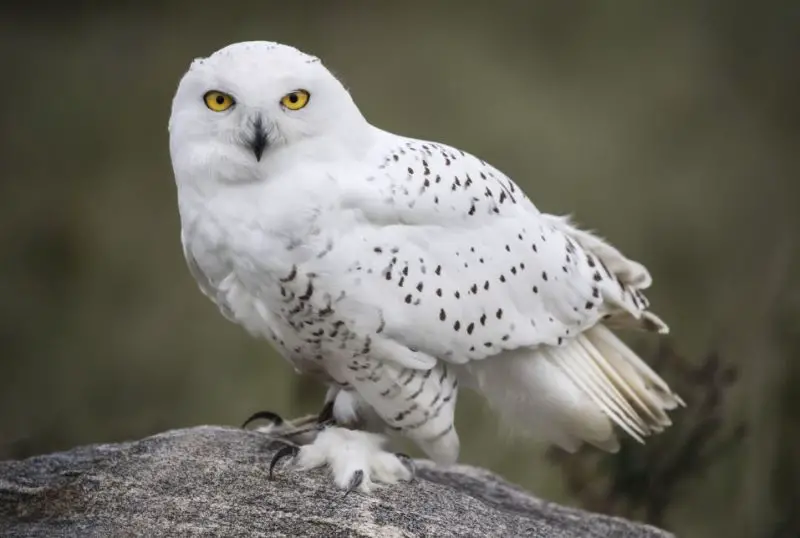
The Snowy Owl is one of the most stunning and easily recognizable owls in the world, known for its bright white plumage and striking golden eyes. Adults stand about 20 to 27 inches tall with a wingspan that can reach nearly 5 feet. Males tend to be whiter overall, while females and young birds have more dark barring across their feathers. Their thick plumage helps them withstand frigid temperatures in their native Arctic tundra.
Unlike most owls, Snowy Owls are diurnal, hunting primarily during the day. They have a calm, confident posture and prefer open landscapes similar to their tundra habitat, such as airports, farmland, and coastal areas. Their flight is strong and direct, often compared to that of a hawk. When present in Tennessee, they are usually seen perched on fence posts or open fields, surveying for prey.
Snowy Owls mainly feed on lemmings in their Arctic breeding grounds, but in Tennessee, they prey on small mammals like rabbits, voles, and mice. They can also hunt birds such as ducks and pigeons. Their hunting style involves patiently scanning large open areas before swooping down silently on their prey.
In Tennessee, Snowy Owls are extremely rare visitors, appearing only during irruption years when food is scarce in the far north. These irruptions bring them much farther south than usual, sometimes reaching the central United States. Sightings in Tennessee are special and often occur during unusually harsh northern winters.
Burrowing Owl (Athene cunicularia)
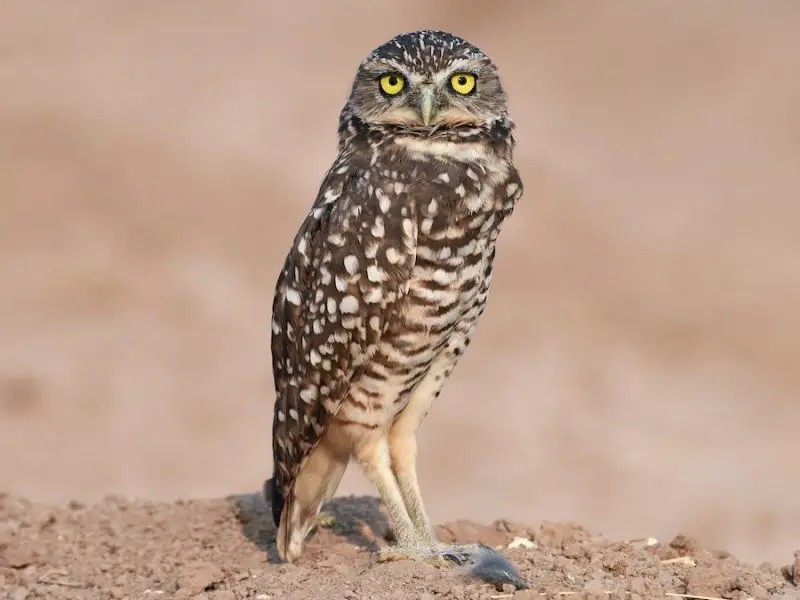
The Burrowing Owl is a small, long-legged species that behaves quite differently from most other owls. Measuring around 7 to 10 inches tall with a wingspan of about 21 inches, this owl stands out for its bright yellow eyes, short tail, and lack of ear tufts. Its plumage is mottled brown with white spots, and its face has bold white eyebrows that give it a curious expression.
Unlike tree-dwelling owls, Burrowing Owls live and nest in burrows underground, often in abandoned prairie dog or gopher holes. They are primarily active during the day, especially during early morning and late afternoon, although they also hunt at night. Their calls are soft cooing or chattering sounds that vary with mood and behavior.
Their diet includes insects, small mammals, and occasionally small birds or amphibians. They often hunt by running along the ground or hovering briefly before pouncing on prey. During the breeding season, they line their burrows with dried grass and sometimes animal dung to mask their scent and deter predators.
In Tennessee, the Burrowing Owl is an accidental or extremely rare visitor, occasionally appearing in the state’s western or central grasslands. These sightings are infrequent, usually occurring during migration or when birds wander from their normal range in the Great Plains. Their rarity makes them a thrilling find for Tennessee birdwatchers.
Northern Hawk Owl (Surnia ulula)
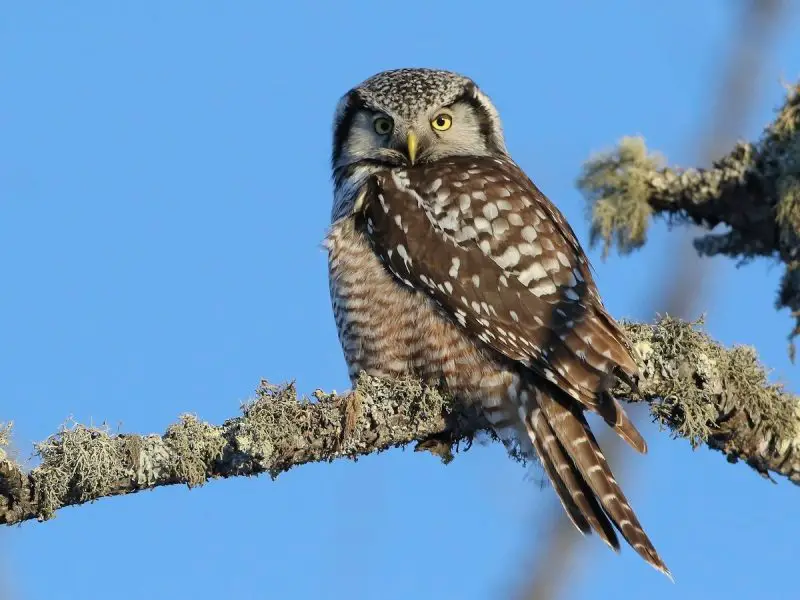
The Northern Hawk Owl is one of the most unusual owl species that may occasionally wander into Tennessee during harsh northern winters. It measures about 14 to 17 inches in length with a wingspan of roughly 28 inches. True to its name, this owl has a long tail and slim body, giving it a hawk-like appearance in flight. Its plumage is grayish-brown with fine barring, and its face is framed by a dark border that accentuates its intense yellow eyes.
Unlike most owls, the Northern Hawk Owl is diurnal, actively hunting during daylight hours. Its sharp vision and quick, direct flight allow it to behave much like a small hawk. It often perches on the tops of trees or poles, scanning for movement before swooping down to seize its prey. Its call is a series of short whistles or chattering notes, most often heard during the breeding season in its northern range.
The diet of this owl consists mainly of small mammals and birds. It relies heavily on sight rather than sound to locate prey, which is an adaptation to the bright daylight conditions of its Arctic breeding grounds. It stores extra food during winter months, wedging it in tree branches or hiding it under snow.
In Tennessee, the Northern Hawk Owl is considered an accidental and extremely rare visitor, typically appearing only during severe irruption years. Most records are from the northern United States, but on rare occasions, a few individuals stray southward into the Appalachian Mountains. Spotting one in Tennessee is a once-in-a-lifetime experience for birders.
FAQs About Owls in Tennessee
When is the best time to see owls in Tennessee?
The best time to observe owls in Tennessee is during the evening and early night hours, when most species are actively hunting. For species like the Barred Owl and Eastern Screech-Owl, dusk and dawn are especially productive periods, as these birds often call and move between roosting sites. During winter months, Tennessee becomes home to several migratory owls such as the Short-eared Owl and Long-eared Owl, which can be spotted in open grasslands and farmlands. The cooler air helps sound carry farther, making owl calls easier to hear on calm nights.
If you want to spot owls visually, look for them on moonlit nights or visit wooded parks and nature reserves near water sources. In spring, listen for territorial hoots, which indicate nesting activity. Always move quietly and use a red light instead of a bright flashlight to avoid disturbing them.
Where can I find owls in Tennessee?
Owls can be found across Tennessee, from the Appalachian Mountains in the east to the Mississippi River Valley in the west. Each species has its preferred habitat: the Barred Owl favors wooded swamps and river corridors, while Great Horned Owls thrive in open forests and farmlands. Eastern Screech-Owls adapt well to suburban neighborhoods, parks, and even backyard nest boxes.
For winter visitors like the Short-eared Owl, head to open areas such as Reelfoot Lake, Shelby Farms Park in Memphis, or grasslands near the Tennessee National Wildlife Refuge. These areas offer ideal hunting grounds for rodents, attracting migratory owls during colder months.
What do owls eat in Tennessee?
Owls in Tennessee are carnivorous and feed primarily on small mammals such as mice, voles, shrews, and rabbits. Larger species like the Great Horned Owl can take more substantial prey, including squirrels, skunks, and even other birds. Smaller species like the Eastern Screech-Owl and Northern Saw-whet Owl hunt insects, small birds, and amphibians.
Owls swallow their prey whole and later regurgitate indigestible parts—bones, fur, and feathers—in the form of pellets. Farmers and gardeners often welcome Barn Owls because they consume hundreds of rodents per year, helping naturally control pest populations.
Are owls active during the day in Tennessee?
Most owls in Tennessee are nocturnal, meaning they are most active at night. However, some species show diurnal or crepuscular tendencies. The Short-eared Owl and Burrowing Owl are frequently active during daylight hours, especially early in the morning or late in the afternoon. The Snowy Owl, during its rare visits, also hunts by day due to its adaptation to the Arctic’s long daylight periods.
If you happen to spot an owl during daylight, it may be roosting quietly in a tree or hunting in open areas where prey is abundant. Always observe from a respectful distance and avoid using flash photography, as bright lights can stress the birds.
How can I identify owls by their calls in Tennessee?
Each owl species in Tennessee has a distinct vocal signature. The Barred Owl is famous for its rhythmic “Who cooks for you? Who cooks for you all?” call, while the Great Horned Owl produces deep, resonant hoots in a “hoo-hoo-hoo-hoo-hoo” pattern. The Eastern Screech-Owl gives a trembling or whinny-like trill, and the Barn Owl emits an eerie, hissing scream rather than a hoot.
During winter, you might hear the Short-eared Owl’s soft barks or the Long-eared Owl’s low, deep “hoo” repeated at intervals. Learning these calls can help birdwatchers identify species in darkness when visual spotting is difficult. Mobile birding apps and local nature centers often provide sound libraries for practice.
Are any owl species endangered or protected in Tennessee?
All owl species in Tennessee are protected under the Migratory Bird Treaty Act, which makes it illegal to harm, capture, or possess them without a permit. While none of the state’s regular owl species are currently endangered, some populations are declining due to habitat loss and changes in agricultural practices. The Barn Owl, for instance, has seen local declines as old barns and hollow trees—its traditional nesting sites—disappear.
Conservation groups in Tennessee encourage installing nest boxes for Barn Owls and preserving old-growth forests for woodland species like the Barred Owl and Eastern Screech-Owl. Observing these birds responsibly supports both their survival and public appreciation for Tennessee’s diverse owl population.
What should I do if I find a baby or injured owl?
If you discover a baby owl on the ground, it’s important not to assume it has been abandoned. Many young owls, especially Barred or Screech-Owls, go through a “branching” stage where they leave the nest but are still cared for by their parents. If the bird appears healthy, leave it alone and observe from a distance.
However, if the owl is clearly injured or in immediate danger, contact a licensed wildlife rehabilitator or local animal rescue center. In Tennessee, organizations like Walden’s Puddle Wildlife Rehabilitation Center near Nashville can provide proper care. Never attempt to feed or handle a wild owl, as this can cause stress or injury to both you and the bird.



